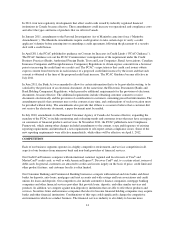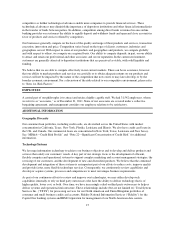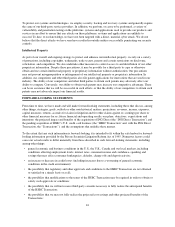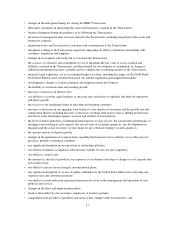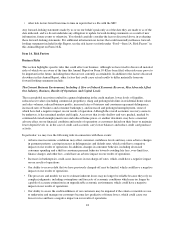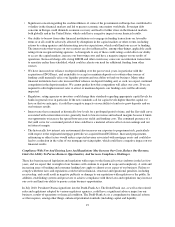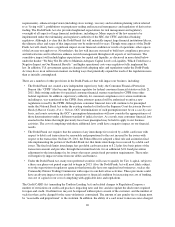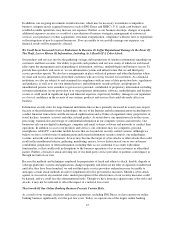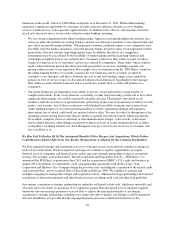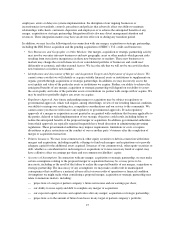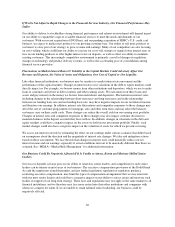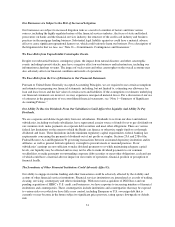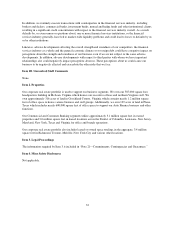Capital One 2011 Annual Report Download - page 42
Download and view the complete annual report
Please find page 42 of the 2011 Capital One annual report below. You can navigate through the pages in the report by either clicking on the pages listed below, or by using the keyword search tool below to find specific information within the annual report.•Charge-off Recognition. The rules governing charge-off recognition could change.We record charge-offs
according to accounting and regulatory guidelines and rules.These guidelines and rules, including the
FFIEC Account Management Guidance, could require changes in our account management or loss
allowance practices and cause our charge-offs to increase for reasons unrelated to the underlying
performance of our portfolio.Such changes could have an adverse impact on our financial condition or
results of operation.
•Industry Practices. Our charge-off and delinquency rates may be negatively impacted by industry
developments, including new regulations applicable to our industry.
•Collateral. Collateral, when we have it, could be insufficient to compensate us for loan losses.When
customers default on their loans and we have collateral, we attempt to seize it where permissible and
appropriate.However, the value of the collateral may not be sufficient to compensate us for the amount of
the unpaid loan, and we may be unsuccessful in recovering the remaining balance from our customers.
Particularly with respect to our commercial lending and home loan activities, decreases in real estate values
adversely affect the value of property used as collateral for our loans and investments.Thus, the recovery of
such property could be insufficient to compensate us for the value of these loans. Borrowers may be less
likely to continue making payments on loans if the value of the property used as collateral for the loan is
less than what the borrower owes, even if the borrower is still financially able to make the payments.
•New York Concentration. Although our lending is geographically diversified, approximately 48% of our
commercial loan portfolio is concentrated in the New York metropolitan area. The regional economic
conditions in the New York area affect the demand for our commercial products and services as well as the
ability of our customers to repay their commercial loans and the value of the collateral securing these loans.
An economic downturn or prolonged period of slow economic growth in the New York region could have a
material adverse effect on the performance of our commercial loan portfolio and our results of operations.
We May Experience Increased Losses Associated With Mortgage Repurchases and Indemnification
Obligations.
Certain of our subsidiaries, including GreenPoint Mortgage Funding, Inc. (“GreenPoint”), Capital One Home
Loans and Capital One, N.A., as successor to Chevy Chase Bank, may be required to repurchase mortgage loans
that have been sold to investors in the event there are certain breaches of certain representations and warranties
contained within the sales agreements. We may be required to repurchase mortgage loans that we sell to investors
in the event that there was improper underwriting or fraud or in the event that the loans become delinquent
shortly after they are originated. These subsidiaries also may be required to indemnify certain purchasers and
others against losses they incur in the event of breaches of representations and warranties and in various other
circumstances, including securities fraud claims, and the amount of such losses could exceed the repurchase
amount of the related loans. Consequently, we may be exposed to credit risk associated with sold loans.
We have established reserves in our consolidated financial statements for potential losses that are considered to
be both probable and reasonably estimable related to the mortgage loans sold by our originating subsidiaries. The
adequacy of the reserve and the ultimate amount of losses incurred will depend on, among other things, the actual
future mortgage loan performance, the actual level of future repurchase and indemnification requests, the actual
success rate of claimants, developments in litigation related to us and the industry, actual recoveries on the
collateral and macroeconomic conditions (including unemployment levels and housing prices). Due to
uncertainties relating to these factors, there can be no assurance that our reserves will be adequate or that the total
amount of losses incurred will not have a material adverse effect upon our financial condition or results of
operations. For additional information related to our mortgage loan repurchase and indemnification obligations
and related reserves and our estimate of the upper end of the reasonably possible future losses from
representation and warranty claims beyond the current accrual levels as of December 31, 2011, see “Note 21—
Commitments, Contingencies and Guarantees.”
22




